| Srl | Item |
| 1 |
ID:
064719
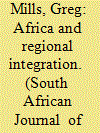

|
|
|
|
|
| Publication |
Winter/Spring 2004.
|
|
|
|
|
|
|
|
|
|
|
|
|
|
|
|
| 2 |
ID:
173803
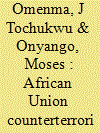

|
|
|
|
|
| Summary/Abstract |
Attacks from violent extremist organisations have reached unprecedented levels in Africa. Boko Haram, al-Shabaab, al-Qaeda in the Islamic Maghreb and Islamic State and Sinai Peninsula activities account for the majority of high attacks and fatality rates. Their membership cuts across national borders; some have established a presence in local communities, while others are controlling territories in a number of states. This continues to happen despite regional measures such as the Algiers Plan of Action on the Prevention and Combating of Terrorism (2002) and the African Model Anti-Terrorism Law (2011) to contain the activities of violent extremist groups on the continent. The prevailing argument shows that the African Union has initiated several legislations and protocols to contain terrorism on the continent, but the Union lacks the capacity to enforce legislations. Relying on the cost–benefit theoretical explication, we conclude that member states of the East African Community prefer to partner with external organisations in counterterrorism programmes which result in conflicting cross-border rules and challenges in countering violent extremism in Africa.
|
|
|
|
|
|
|
|
|
|
|
|
|
|
|
|
| 3 |
ID:
131029
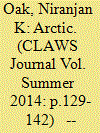

|
|
|
|
|
| Publication |
2014.
|
| Summary/Abstract |
Regionalism as a political project has been a signi?cant phenomenon in post-1945 international relations. The third phase of regional integration began towards the end of the 19805 within the international context created by the end of the Cold War. Academics dubbed it as "new regionalism".' Most of the regional organisations that came up in those days were based on economic cooperation among the states. It was an era of globalisation. The Arctic Council (AC) which emerged in 1996 was a unique case. The 'Arctic' has emerged as a region in international cooperation during the past 20-30 years, as manifest in the creation of the AC. The objective of the AC was sustainable development and environmental protection only, and that is why it may be termed as a unique case in that period.
|
|
|
|
|
|
|
|
|
|
|
|
|
|
|
|
| 4 |
ID:
098932
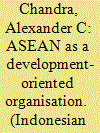

|
|
|
| 5 |
ID:
101602
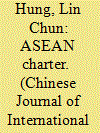

|
|
|
|
|
| Publication |
2010.
|
| Summary/Abstract |
Southeast Asia is a region rooted in cultural, ethnic, geographic and developmental diversity but generally viewed as a united bloc. Under the steady expansion of globalization and the drastic competition from neighbouring regions, regionalization in Southeast Asia is confronting new challenges and entering a new era. To deal with this, national leaders from the Association of Southeast Asian Nations (ASEAN) Member States decided in 2008 to adopt a new agreement, the ASEAN Charter, to aim for deeper integration in the future. What are the differences in ASEAN's position in the international community after adopting the ASEAN Charter? This article plans to analyse ASEAN's developmental challenges and the legal contents of the ASEAN Charter, as well as to compare some of the European Union's experiences in order to assess ASEAN's new status under international law.
|
|
|
|
|
|
|
|
|
|
|
|
|
|
|
|
| 6 |
ID:
158547
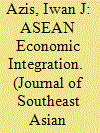

|
|
|
|
|
| Summary/Abstract |
Over the past five decades, the Association of Southeast Asian Nations (ASEAN) has made tremendous economic progress. While the continuous improvements in the region’s macroeconomic indicators might give the impression that this growth trend can be sustained smoothly in the long run, that might not necessarily be the case. In this paper, three imminent challenges are discussed — changing patterns of investment, slowing productivity, and the China factor. For the Association to cope with these risks and forge new development paths, structural reforms within, and deeper integration between its member states are imperative.
|
|
|
|
|
|
|
|
|
|
|
|
|
|
|
|
| 7 |
ID:
045961
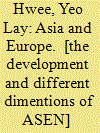

|
|
|
|
|
| Publication |
London, Routledge, 2003.
|
| Description |
xiii, 234p.
|
| Standard Number |
0415306973
|
|
|
|
|
|
|
|
|
|
|
|
Copies: C:1/I:0,R:0,Q:0
Circulation
| Accession# | Call# | Current Location | Status | Policy | Location |
| 046964 | 327.405/HWE 046964 | Main | On Shelf | General | |
|
|
|
|
| 8 |
ID:
100143
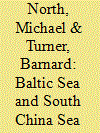

|
|
|
| 9 |
ID:
103861
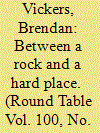

|
|
|
|
|
| Publication |
2011.
|
| Summary/Abstract |
This article explores the role and effectiveness of small state trade diplomacy in the negotiations to conclude Economic Partnership Agreements (EPAs) between the European Union (EU) and the African, Caribbean and Pacific (ACP) group of countries, focusing specifically on the Southern African Development Community (SADC). Given the vast power asymmetries between the EU and the ACP, small states have had limited bargaining power to shape the process and the outcome of the negotiations. Unlike most other ACP EPA negotiations, the SADC small states were also caught between a rock (EU) and a hard place (South Africa), with both parties competing to promote their visions for regional integration. In the end, the EPA process split SADC into four sets of separate trade regimes with the EU, undermining the established regional integration project. The article explains this divisive outcome of the SADC EPA process by analysing the negotiation behaviour of the main parties, specifically the 'weaker' players. The article concludes with key lessons for small states' future trade negotiations.
|
|
|
|
|
|
|
|
|
|
|
|
|
|
|
|
| 10 |
ID:
069244
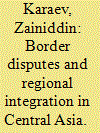

|
|
|
| 11 |
ID:
121439
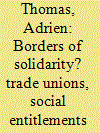

|
|
|
|
|
| Publication |
2013.
|
| Summary/Abstract |
This article explores the effects of borders on the making of trade union policies and on their capacity to act. It takes as an entry-point the reform of Luxembourg's system of family allowances and financial support for students in 2010, which redefined the group of beneficiaries and partly excluded cross-border workers from neighbouring countries. This led to heated debates in Luxembourg and in the Greater Region (comprising Luxembourg, Saarland, Rhineland-Palatinate, Lorraine and Wallonia) during which trade unions played an important part. The author explores the contradictory logics of both competition and cooperation within the Greater Region. These lead to a gap between integration as a discourse and what it means for local populations, in particular regarding labour market competition. The debates within trade unions on the issue of social entitlements for cross-border workers offer insights into the dynamics of this dichotomy and into the everyday fabric of cross-border social relations.
|
|
|
|
|
|
|
|
|
|
|
|
|
|
|
|
| 12 |
ID:
111547
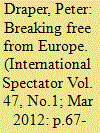

|
|
|
|
|
| Publication |
2012.
|
| Summary/Abstract |
Support for regional economic integration in Africa runs high amongst the continent's international development partners and African elites. However, its expression in European forms of economic integration is not appropriate to regional capacities and in some cases may do more harm than good. This lacuna is exacerbated by technical and theoretical analyses rooted either in economics or international relations literature. This article sets out to reconceptualise the foundations of African economic integration by reviewing key debates within each literature and comparing the results across disciplinary boundaries. Overall, it is concluded that a much more limited approach is required, one that prioritises trade facilitation and regulatory cooperation in areas related primarily to the conduct of business; underpinned by a security regime emphasizing the good governance agenda at the domestic level. Care should be taken to design the ensuing schemes in such a way as to avoid contributing to major implementation and capacity challenges in establishing viable and legitimate states. In doing so, the presence of regional leaders with relatively deep pockets - South Africa in the Southern African case - points to the imperative of building such limited regional economic arrangements around key states.
|
|
|
|
|
|
|
|
|
|
|
|
|
|
|
|
| 13 |
ID:
076447
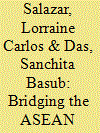

|
|
|
| 14 |
ID:
053194
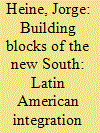

|
|
|
|
|
| Publication |
Jan-Jun 2004.
|
|
|
|
|
|
|
|
|
|
|
|
|
|
|
|
| 15 |
ID:
160899
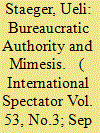

|
|
|
|
|
| Summary/Abstract |
Regional economic integration in the post-Soviet space stands in a complex relation with the European Union’s integration process. Multiple competing internal logics of integration, as well as the EU model are drivers of Eurasian regionalism. The Eurasian Economic Union illustrates how bureaucracies mobilise their technocratic authority in a process of mimesis that reconciles multiple internal and external integration logics: selective learning from the EU and successful incorporation of internal integration logics produce an organisational design and output that member states support to varying extents.
|
|
|
|
|
|
|
|
|
|
|
|
|
|
|
|
| 16 |
ID:
064724
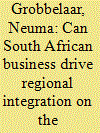

|
|
|
|
|
| Publication |
Winter/Spring 2004.
|
|
|
|
|
|
|
|
|
|
|
|
|
|
|
|
| 17 |
ID:
075409
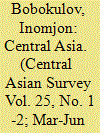

|
|
|
| 18 |
ID:
085829
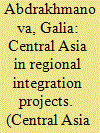

|
|
|
|
|
| Publication |
2008.
|
| Summary/Abstract |
From the very first days of their independence the post-Soviet Central Asian states rich in natural resources and ruled by elites with little (if any) experience in international affairs have been objects of close attention by external players who hastened to the Eurasian geopolitical arena to put pressure on what looked like easy prey. Today multisided integration structures have been and remain a popular lever of pressure.
|
|
|
|
|
|
|
|
|
|
|
|
|
|
|
|
| 19 |
ID:
140037
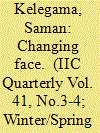

|
|
|
| 20 |
ID:
152274
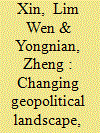

|
|
|
|
|
| Summary/Abstract |
As the world’s second-largest economy, China is set to gradually shape and reconstruct the international order. In 2013, the Chinese leadership announced the “One Belt, One Road” initiative as a strategic construct of Chinese peripheral influence and regional integration. As a great power, China needs to take the initiative to go beyond its responsibility as a “developing nation”. While China and the United States share many common interests and highly interdependent economic relations, a new world order is viable only with the cooperation of China and the United States.
|
|
|
|
|
|
|
|
|
|
|
|
|
|
|
|